NCERT Solutions for Class 10 Chapter 11 Electricity: In this article, we will provide you all the information regarding NCERT Solutions for Class 10 Science Physics Chapter 11 Electricity. By working on NCERT Class 10 Physics electricity questions and answers, you will be able to score high marks in the board examination and the CBSE class 10 board examination.
NCERT Solutions for Class 10 Electricity class 10 will not only help you in preparing for the board exam but also in clearing the competition exams like Engineering. You can also find the class 10 numericals for Electricity class 10 with solutions which will help you in solving your assignments. So, read everything about NCERT Solutions For Science Chapter 11 Electricity Class 10.
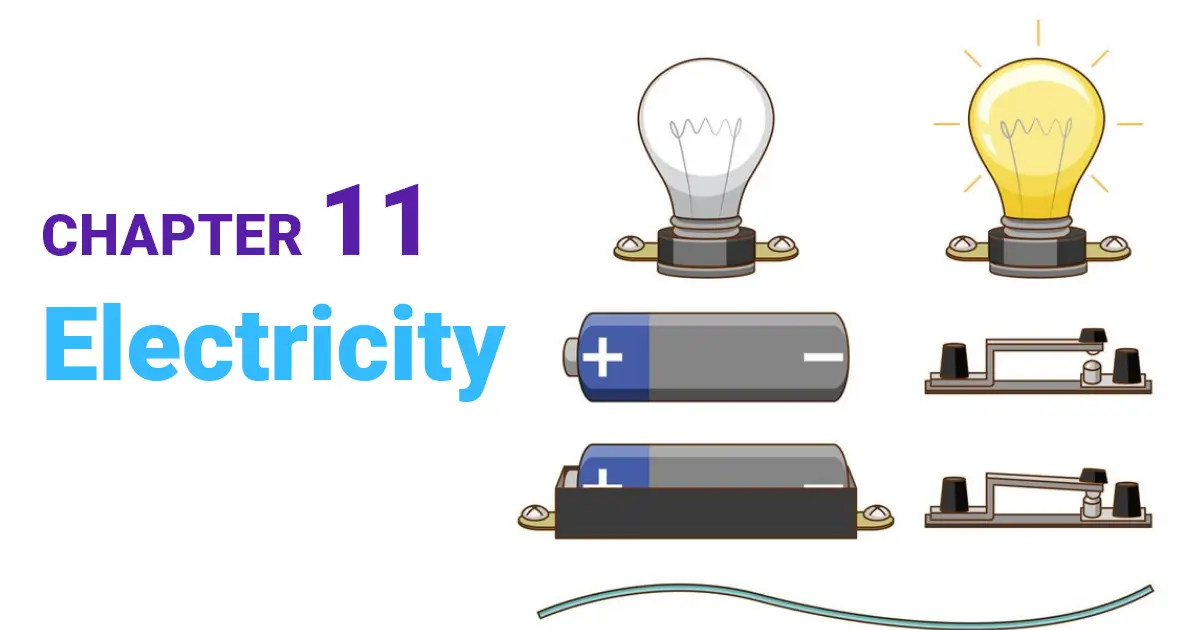
NCERT Solutions for Class 10 Chapter 11 Electricity
Before going into the specifics of NCERT solutions for Class 10 Science Chapter 11 Electricity, let us have a brief overview of the topics and sub-topics under Class 10 Electricity NCERT solutions:
- Electricity
- Electric Current And Circuit
- Electric Potential And Potential Difference
- Circuit Diagram
- Ohm’S Law
- Factors On Which The Resistance Of A Conductor Depends
- Resistance Of A System Of Resistors
- Heating Effect Of Electric Current
- Electric Power
Maths Important Questions for Class 10 NCERT (PDF)
Notes Kaise Banaye: Top 5 स्टडी नोट्स बनाने के सही तरीके
Electricity Notes Class 10th Chapter 11 Easy To Learn (NCERT 2023)
New NCERT Book Class 10 Download Rationalised Chapters PDF
NCERT Solutions for Class 10 Chapter 11 Electricity
Download free NCERT Solutions Notes and NCERT Solutions for Class 10 Chapter 11 Electricity PDF in Hindi and English Medium.
For CBSE, Bihar, Gujarat, and UP Board students, who are using NCERT Books based on the updated CBSE Syllabus.
NCERT Solutions for Class 10 Chapter 11 Electricity Textbook Solutions
Question 1
A piece of wire of resistance R is cut into five equal parts. These parts are then connected in parallel. If the equivalent resistance of this combination is R’, then the ratio R/R’ is :
(a) 125
(b) 15
(c) 5
(d) 25
Answer: (d) 25
Question 2
Which of the following terms does not represent electrical power in a circuit?
(a) I2R
(b) IR2
(c) VI
(d) v22
Answer: (fa) IR2
Question 3
An electric bulb is rated 220 V and 100 W. When it is operated on 110 V, the power consumed will be :
(a) 100 W
(b) 75 W
(c) 50 W
(d) 25 W
Answer: (d) 25 W
Question 4
Two conducting wires of the same material and of equal lengths and equal diameters are first connected in series and then parallel in a circuit across the same potential difference. The ratio of heat produced in series and parallel combinations would be :
(a) 1 : 2
(b) 2 : 1
(c) 1 : 4
(d) 4 : 1
Answer: (c) 1 : 4
Question 5
How is a voltmeter connected in the circuit to measure the potential difference between two points ?
Answer:
A voltmeter is connected in parallel to measure the potential difference between two points.
Question 6
A copper wire has diameter 0.5 mm and resistivity of 1.6 x 10-8 Ω m. What will be the length of this wire to make its resistance 10 Ω ? How much does the resistance change if the diameter is doubled ?
Answer:


If a wire of diameter doubled to it is taken, then the area of the cross-section becomes four times.
New resistance = 102 = 2.5 Ω, Thus the new resistance will be 14 times.
Decrease in resistance = (10 – 2.5) Ω = 7.5 Ω
Question 7
The values of current I flowing in a given resistor for the corresponding values of potential difference V across the resistor are given below :
| I (amperes) | 0.5 | 1.0 | 2.0 | 3.0 | 4.0 |
| V (volts) | 1.6 | 3.4 | 6.7 | 10.2 | 13.2 |
Plot a graph between V and I and calculate the resistance of the resistor.
Answer:
The graph between V and I for the above data is given below.
The slope of the graph will give the value of resistance.
Let us consider two points P and Q on the graph.
and from P along the Y-axis, which meets at point R.
Now, QR = 10.2V – 34V = 6.8V
And PR = 3 – 1 = 2 ampere
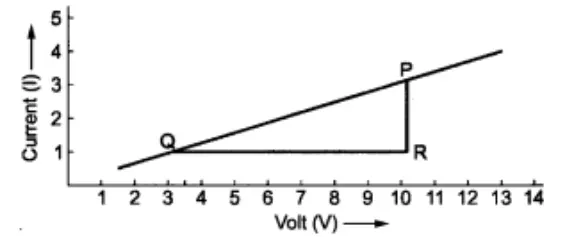
Slope = PR/QR
= I/V = 1/R
= 2/6.8 = 1/3.4
Thus, resistance, R = 3.4 Ω
Question 8
When a 12 V battery is connecte across an unknown resistor, there is a current of 2.5 mA in the circuit. Find the value of the resistance of the resistor.
Answer:
Here, V = 12 V and I = 2.5 mA = 2.5 x 10-3 A
∴ Resistance, R = VI = 12V2.5×103A = 4,800 Ω = 4.8 x 10-3 Ω
Question 9
A battery of 9V is connecte in series with resistors of 0.2 O, 0.3 O, 0.4 Q, 0.5 Q and 12 £1, respectively. How much current would flow through the 12 Q resistor?
Answer:
Total resistance, R = 0.2 Ω + 0.3 Ω + 0.4 Ω + 0.5 Ω + 12 Ω – 13.4 Ω
Potential difference, V = 9 V
Current through the series circuit, I = VR = 12V13.4Ω = 0.67 A
∵ There is no division of current in series. Therefore current through 12 Ω resistor = 0.67 A.
Question 10
How many 176 Ω resistor (in parallel) are require to carry 5 A on a 220 V line?
Answer:
Suppose n resistor of 176 Ω are connecte in parallel.

Thus 4 resistor are need to be connecte.
Question 11
Show how you would connect three resistors, each of resistance 6 Ω, so that the combination has a resistance of (i) 9 Ω, (ii) 4Ω
Answer:
Here, R1 = R2 = R3 = 6 Ω.
(i) When we connect R1 in series with the parallel combination of R2 and R3 as shown in Fig. (a).
The equivalent resistance is

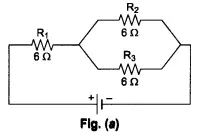
(ii) When we connect a series combination of R1 and R2 in parallel with R3, as shown in Fig. (b), the equivalent resistance is

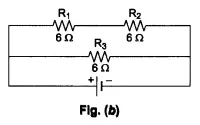
Question 12
Several electric bulbs designe to use on a 220 V electric supply line, are rate 10 W. How many lamps can be connecte in parallel with each other across the two wires of 220 V line if the maximum allowable current is 5 A?
Answer:
Here, current, I = 5 A, voltage, V = 220 V
∴ Maxium power, P = I x V = 5 x 220 = 1100W
Required no. of lamps =Max.PowerPowerof1lamp=110010=110
∴ 110 lamps can be connecte in parallel.
Question 13
A hot plate of an electric oven connected to a 220 V line has two resistance coils A and B, each of 24 Ω resistance, which may be used separately, in series, or in parallel. What are the currents in the three cases ?
Answer:
(i) When the two coils A and B are use separately. R = 24 Ω, V = 220 V
Current I = V/R = 220V/24 Ω = 9.167 A
(ii) Two coils are connecte in series,
R = 24 Ω + 24 Ω = 48 Ω
V = 220V
Current, I = V/R = 220v/28 Ω = 4.58 A
(iii) When the two coils are connecte in parallel.
R = 24 * 24/ 24+24 = 12 Ω
V = 220 V
Current I = V/R = 220V/12 Ω = 18.33 A
Question 14
Compare the power used in the 2 Ω resistor in each of the following circuits
(i) a 6 V battery in series with 1 Ω and 2 Ω resistors, and
(ii) a 4 V battery in parallel with 12 Ω and 2 Ω resistors.
Answer:
(i) The circuit diagram is show in figure.
Total resistance, R = 1Ω + 2Ω = 3Ω
Potential difference, V = 6 V
Power used in 2Ω resistor = I2R = (2)2 x 2 = 8 W
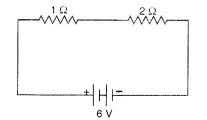
(ii) The circuit diagram for this case is show:
Power used in 2 resistor = v2R =422 = 8 W.
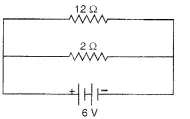
Question 15
Two lamps, one rated 100 W at 220 V, and the other 60 W at 220 V, are connecte in parallel to the electric mains supply. What current is drawn from the line if the supply voltage is 220 V?
Answer:
Power of first lamp (P1) = 100 W
Potential difference (V) = 220 V
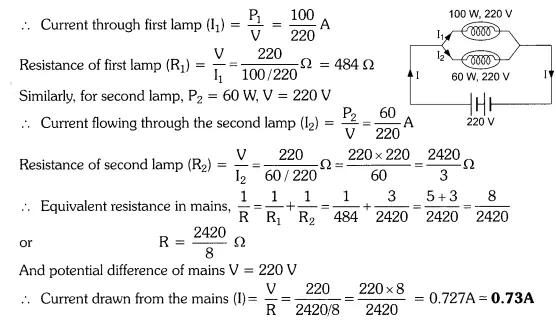
Question 16
Which uses more energy, a 250 W TV set in 1 hr, or a 1200 W toaster in 10 minutes?
Answer:
Energy used by 250 W TV set in 1 hour = 250 W x 1 h = 250 Wh
Energy used by 1200 W toaster in 10 minutes = 1200 W x 10 min
= 1200 x 1060 = 200 Wh 60
Thus, the TV set uses more energy than the toaster.
Question 17
An electric heater of resistance 8 Ω draws 15 A from the service mains 2 hours. Calculate the rate at which heat is developed in the heater.
Answer:
Here, R = 8 Ω, 1 = 15 A, t = 2 h
The rate at which heat is developed in the heater is equal to the power.
Therefore, P = I2 R = (15)2 x 8 = 1800 Js-1
Question 18
Explain the following:
(i) Why is tungsten used almost exclusively for filament of electric lamps ?
(ii) Why are the conductors of electric heating devices, such as bread-toasters and electric irons, made of an alloy rather than a pure metal ?
(in) Why is the series arrangement not used for domestic circuits ?
(iv) How does the resistance of a wire vary with its area of cross-section ?
(v) Why are copper and aluminium wires usually employed for electricity transmission?
Answer:
Tungsten is mainly use in tungsten filament for electric lamps due to its very high melting point of 3300°C, which allows electricity to pass through the tungsten filament and provide heat and light energy, without melting.
An alloy is use instead of a pure metal for conductors for electric heating devices like bread toasters or electric irons, as the resistivity of the alloy is much greater than that of the pure metal, and the alloy does not easily oxidize or burn, even at high temperatures.
The series arrangement is not suitable for domestic circuits, as if one electrical appliance fail due to a defect in the series circuit, all other appliances will also fail because the whole circuit will be broken.
The resistance of a wire is proportional to its cross-section, i.e. Resistance R = 1 /πr2. If the cross-section of a fixed-length conductor increases, then the resistance decreases because more free electrons are available for movement in the conductor.
Short Electricity Notes Class 10th Chapter 11
Electric Charge:
Electric charge is a fundamental property of matter.
There are two types of charges: positive (+) and negative (-).
Like charges repel each other, while opposite charges attract.
Conductors and Insulators:
Conductors are materials that allow electric charges to flow easily. Examples include copper and aluminum.
Insulators are materials that inhibit the flow of electric charges. Examples include rubber, plastic, and glass.
Current, Voltage, and Resistance:
Electric Current (I) is the flow of electric charges through a conductor. It is measure in Ampere (A).
Voltage (V) is the electrical potential difference between two points and is measure in Volts (V).
Resistance (R) is a property of a material that opposes the flow of electric current. It’s measure in Ohm (Ω).
The relationship between voltage, current, and resistance is given by Ohm’s Law: V = I * R.
Circuits:
An electric circuit is a closed path through which electric current can flow.
Circuits can be series or parallel. In a series circuit, current has only one path to flow, while in a parallel circuit, current can split into multiple paths.
Resistors: Components that introduce resistance into a circuit to control the flow of current.
Direct Current (DC) and Alternating Current (AC):
Direct Current (DC) flows in one direction and is often produced by batteries and DC power sources.
Alternating Current (AC) changes direction periodically. It’s the type of current use in most household and industrial applications.
ELECTRIC CURRENT AND CIRCUIT
Electric Current
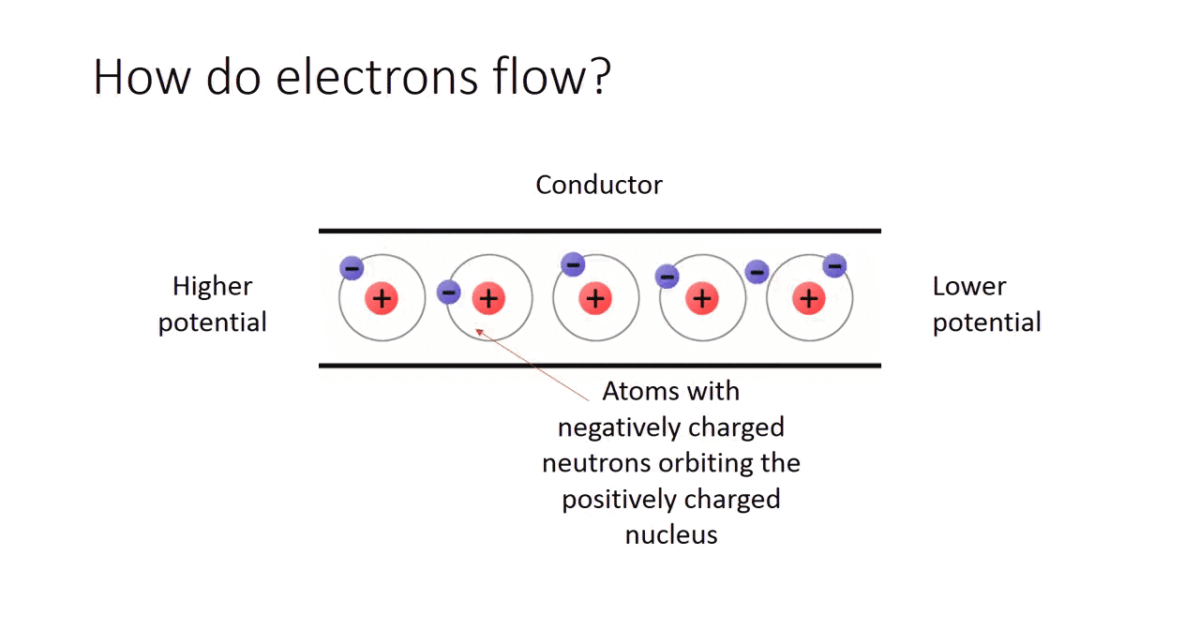
An Electric current refers to the flow of electric charge in a conductor. It is measure in ampere (A) and is represente by the symbol “I.”
Electric current can take two forms: direct current (DC) and alternating current (AC).
Direct Current (DC):
- In a DC circuit, electric charge flows in one direction, from the positive terminal of a voltage source (like a battery) to the negative terminal.
- DC is commonly used in batteries and electronic devices where a constant voltage is required.
Alternating Current (AC):
- In an AC circuit, the direction of electric charge periodically reverses, usually at a fixed frequency (measured in Hertz, Hz).
- AC is what is commonly delivered to homes and businesses by power utilities. It can be easily transformed into different voltages using transformers, making it suitable for long-distance transmission.
Electric current is governe by Ohm’s law, which relates current (I), voltage (V), and resistance (R) in a circuit:
[I = \frac{V}{R}]
Where:
- (I) is the current in amperes (A).
- (V) is the voltage in volts (V).
- (R) is the resistance in ohms (Ω).
Without a voltage difference (also known as an electric potential difference) in an electrical circuit, there will be no electric current.
Voltage is the force or push that causes electric charges (like electrons) to move through a conductor (like a wire).In simpler terms:
-Voltage is what makes electric charges move.
-Current is the flow of those electric charges

Leave a Reply